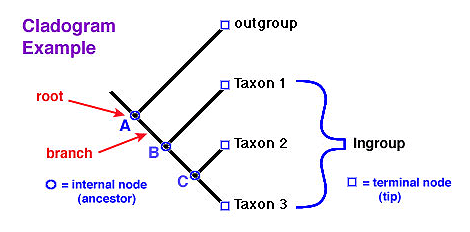Wolf Biology
Because a thing can be done, doesn’t necessarily mean that it should be done. Wolves and dogs both have 78 chromosomes, and it’s due to the evolutionary divergence of the dog from it's progenitor, the wolf, that we enjoy the company of domestic dogs today. Although hybridization is technically possible, how often does that really occur in nature? Not as often as one might think, or believe.
The Cladogram
The Cladogram depicts a family hierarchy as a branching diagram. Each branch is a “clade”, or an ancestor plus the lineage of it’s descendants. Put all of the ancestors together in a biological hierarchy, and a cladogram is the result.

Heirarchies can be broken down according to Taxa. It is through the heirarchal process that correct ancestry can be determined, usually by graphing the broadest collection of shared traits and then consecutively narrowing them. For example, all mammals share something not found in all other types of animals:
- three middle ear bones
- hair
- the ability to produce milk
The class of mammals (mammilia) contains about 5000 species placed in 26 orders. Somewhere in that maze lies the evolutionary history of the dog. It’s starting point, we now know, was the wolf.
Carnivora
This Order broadly separates mammals into two divisions: water-based and land-based. The latter further separate land-living mammals into seven different families: bears, racoons, weasels, civets, hyenas, cats and dogs.
Canis
Within the Genus Canis, are C. lupus (Gray Wolf), C. latrans (coyote) and C. aureus (jackal). The Red Wolf, C. rufus, has since been added as well. C. lupus familiaris is the current preferred classification for the dog.
The DNA Study
For many years, the identity of the dog’s historical predessor has been mired in confusion. Some said it was the jackal, others the coyote, or the wolf. Perhaps all of the above. Fortunately, recent DNA evidence has narrowed it down to just one animal, Canis lupus.
The international team that undertook this landmark genetic study examined mitochondrial DNA rather than chromosomal DNA because the former mutates much more rapidly than the latter. When dealing with closely related species such as dogs and wolves, such a choice is a necessity when examining evolutionary divergence.
Based on the results of this study, which involved 140 dogs from 67 different breeds, and 162 wolves from differing populations in Asia, Europe and North America, we know now the following:
- The largest and most diverse group contained DNA sequences from ancient dog breeds like the Dingo and the New Guinea singing dog, as well as some modern breeds like the collie and the retriever;
- Sequences taken from the Elkhound and the German Shepherd, as well as some other breeds, most closely resembled certain wolf sequences;
- There were no matches to any wolf populations living today.
Interbreeding Was A Rare Event
Robert Wayne, of UCLA, purports that the absence of wolf sequences in Clade I tells the story of how difficult interbreeding was, and that ancient people took the easiest route in this matter: having domesticated dogs, they interbred them with other dogs, rather than wolves. If the reverse were true, according to Wayne, you’d find more similiar wolf sequences in the dog clades. (Wayne, 1997).
A letter from the researchers engaged in this project, and published in Science magazine, re-iterate the importance of this finding:
“Our contention that this was a rare event was not based on the ability to enforce a selective breeding program, but on data showing that only a few Clades of dogs evolved from wolves. If domestication were a common event, dog and wolf haplotypes would be mixed to a much greater extent than they are. The vast majority of dog haplotypes are found in a single clade, which indicates that domestication was a rare event.”
The letter continues, addressing behavorial characteristics of wolves and feral dogs in the present:
“Today, where feral dogs and wolves overlap, interbreeding has hade little impact on the gene pools of the wild or domestic populations. Moreover, all species in the genus Canis can interbreed, but they rarely do so when their ranges overlap. There are potentionally many ecological and behavioral reasons why dogs and wolves would not interbreed that do not requiore active interference by humans.”
NEXT
